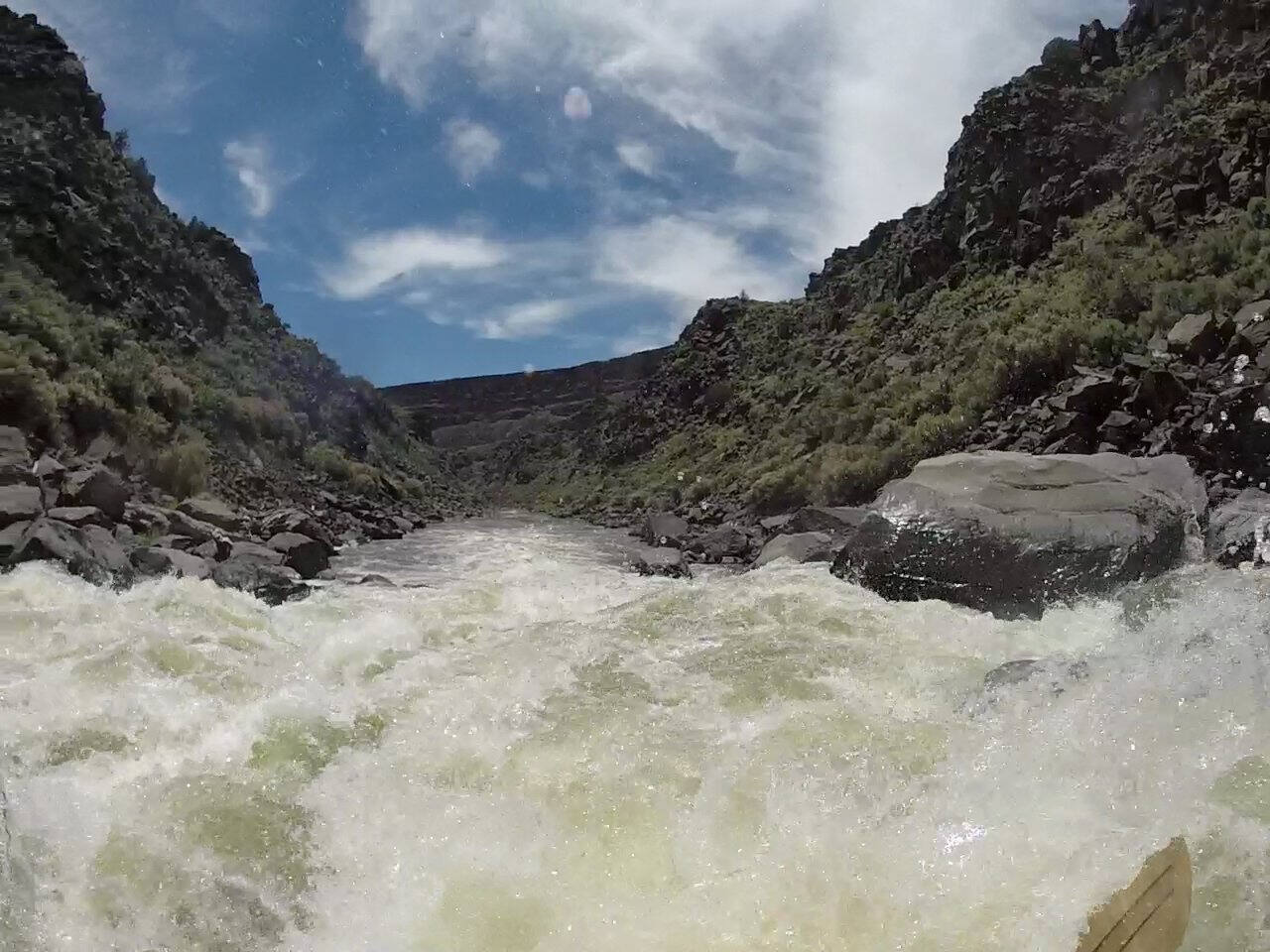White Water Rafting Glossary Terms
Eddy
An eddy is a river feature that forms just downstream of an obstruction. An eddy can form on the side of a river or immediately after a boulder in a river. The water in an eddy is flowing in the opposite direction from the rest of the river and can at times be swirling and violent. Eddys can be used as great safety tools to either slow down in the middle of the river or completely stop. In extremely large volume rivers, eddys can be so powerful that they may cause boats to roll over as the length of the raft is quickly exposed to an opposite flowing current.
Flow
When you ask your rafting guide “what is the flow?,” you will find out what is the current volume of the river. In the United States, river volumes are measured in cubic feet per second. In most other countries, river volumes are measured in cubic meters per second. We are able to track our volumes or “flows” through the United States Geologic Survey who have created gauging stations on most rivers and streams throughout the country. There are up to date recordings found on the USGS website daily. These are important to track for river runners to know what to expect before each white water rafting trip.
High Water
High water varies for each river. Typically, the highest water in Northern New Mexico is found in May and June during the peak snow melt. High water doesn’t always mean more difficult rapids. Sometimes rapids become easier with higher water and sometimes they become more difficult. Ask us what the water conditions are when you reserve your New Mexico rafting trip and we can make sure to direct you to the best available trip according to present water conditions.
Low Water
As is the case with high water, low water does not always mean easier rapids. Sometimes rapids become easier with lower water and sometimes they become more difficult. Lower water or “low flows” are typical of April and later July through September here on the Rio Grande and Rio Chama. Ask one of our friendly staff what the water conditions are in order to find the best trip for you and your group.
Rapid
Rapids are fun and exciting! These are some of the things that make river running the greatest activity available. Specifically, rapids are formed in constricted areas of the river or where there is a significant change in the gradient of the river bed. Usually coming in short spurs, rapids can present a wide variety of difficulty and challenge for rafts to negotiate. There are a variety of world class rapids on the Rio Grande through most sections of river that we raft.
Riffle
This is the tern used to describe a very small and not difficult rapid, usually rated as class 2 or below.
Rapid Classifications
Rapids are classified on a scale of 1-6. Class 1 rapids are basically moving flatwater. Class 6 rapids are defined as runs that have almost never been attempted and often exemplify the extremes of difficulty, unpredictability and danger. The consequences of errors are very severe and rescue may be impossible. For teams of experts only, at favorable water levels, after close personal inspection and taking all precautions. Even though rapid classifications are somewhat subjective, the broad scale allows for enough individual interpretation within each class to make the rating scale relevant. The rapids we enjoy on the Rio Grande and Rio Chama are rated at class 1 to class 4+ and change throughout the season according to water levels.
River Classification
This is how we gauge the difficulty of rapids. If a section of river is comprised of primarily class 3 rapids, it would be a class 3 section of river. In general, the Racecourse section of the Rio Grande is class 3 and the Taos Box section of the Rio Grande is class 4. These are examples of river classifications.
River Left and River Right
These are the terms we use to distinguish points of interest either in the river or on the river bank. When a river runner specifies a side of the river, whether it be “river right” or “river left”, they are always referring to the side of the river in regards to facing downstream. As you look downstream, “river right” is on your right side and “river left” is on your left side. Conversely, when facing upstream, “river right” is on your left side and “river left” is on your right side. Not as confusing as it may sound.
Put-In
This is the term we used to describe the starting point of any rafting trip. This is also one of the most mistaken terms used in river running. If you would like to joke around with your river guide, just ask them where the “put-out” is you will be sure to provide ample entertainment for the entire crew. Trust me, you won’t be the first!
Take-Out
This is the term used to describe the finishing point of any rafting trip. For example, the take-out for the Taos Box section of the Rio Grande is Taos Junction Bridge.
High Side!
This is a command seldom used on rafting trips, however, when performed correctly, can help to keep the boat upright and everyone in the boat. This is one of many commands described by the guide prior to embarking on you trip. This command is used just before collisions with rocks and other obstructions such as large waves or holes. If a crew is quick, the raft’s upstream side is lifted up in time to let the current slide under, rather than into, the raft. This action often prevents the raft from becoming wrapped on a rock or other obstacle and more often prevents the raft from rolling over, or “flipping”.
Biner
Short for Carabiner which means “clip” in Italian. In rafting, biners are used in rope and pulley rescue systems to secure things to a raft and as items of adornment in river guide apparel.
Boulder Garden or Rock Garden
These terms are reserved for a specific type of rapid or short section of river defined by numerous rocks and boulders strewn throughout the channel. Sometimes steep with large boulders and sometimes shallow with numerous rocks just beneath the surface. On the Rio Grande through the Taos Box, this term is also used as the name of one of the most difficult rapids on the river, “Rock Garden”.
D-Ring
Metal, D-shaped ring attached to a raft and used to secure frames, lines, rope thwarts, etc.
Perimeter Line
This is the line, either rope or webbing, which passes through all of the “d-rings” along the outside perimeter of the raft. Thus creating a secure line for those who have fallen out of the raft to grab. When a swimmer has a grasp of the perimeter line, they have a much better chance to get back into the raft as quickly as possible.
Hydraulic/ Reversal or Hole
All of these terms are generally used to describe a specific feature in the river. These are features formed when the river passes over the top of a rock, ledge or other obstacle in the river. When the river current passes over the obstacle, it travels deep toward the bottom of the river and ten “reverses” back onto itself. Larger or more powerful “holes” can easily stop and flip rafts. Smaller and less powerful “hydraulics” can be used to “surf” and provide great entertainment for the entire raft.

